

Introduced: 2008 (first release), 2009 (DCC-Sound version) and 2017 (revised driver version)
Once every decade or so, Kato deigns to favor the North American market with a new steam locomotive. And like their legendary 1996 Mikado model, Kato's GS-4 Northern is an absolute home-run (well, sort of - but more on that in a moment). The paint, detailing and overall looks are stunning. And can we talk about those illuminated numberboards on the side of the engine for a moment? My lord, how cool is that?! And unlike the Mikado, all of the bits and pieces of shell detailing come pre-installed.
Also unlike their earlier Mikado, the shell on this model comes off very easily. The cab is held on by friction and pops off with minimal effort. And once the cab is out of way, the top of the boiler will lift right off -

The chassis is all metal, split-frame and nicely hefty. The motor is an open-sided, skew-wound 3-poler (equipped with a single flywheel). Six of the eight drivers provide pickup (with the third pair from the front being equipped with traction tires). All twelve tender wheels provide pickup as well. The pilot and trailing trucks are electrically neutral. Tender pickup is of the low-friction ilk. Current is transferred from the tender to the engine chassis by way of stiff wires on the plastic drawbar. Only the traction-tire equipped driver pair is geared (with all the rest of the drivers being turned by the running gear). All gearing is plastic. Directional lighting is provided by a PC board mounted on top of the engine chassis (there is no backup light in the tender). Both the pilot and tender are equipped with Kato's automatic (magnetic) knuckle couplers. Wheels are blackened and low-profile, so no problems on Code-55 rails.
This model also sports a couple of other interesting features - first, springs on the rear drivers (which serve to force most of the engine's weight to be carried by the traction-tire equipped #3 drivers). And second, cut bronze axle-end contacts in the tender trucks - making for true floating all-wheel pickup in a 6-wheel truck -
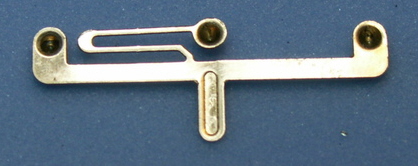
This model is also fully DCC-Ready - with Kato's "EM13" decoder being designed to plug into the tender -
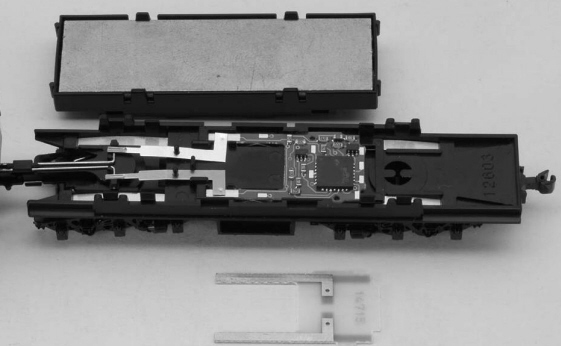
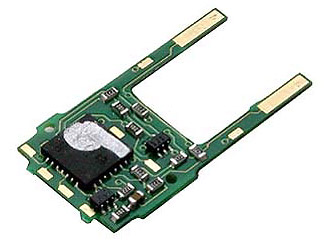
Performance is off the charts - smooth, quiet, responsive, excellent slow speed creepability, great pickup, and with pulling power to spare - in a word, perfect. More amazingly, this locomotive can actually handle extremely narrow radius (9.75") curves (a boast that Con-Cor's GS-4 cannot make). OK, it looks a little silly doing so, but that's beside the point.
Having said all that, I do have a couple of very minor quibbles with this model. First off, I simply don't buy the so-called "Mars Light". Basically it blinks on and off and looks nothing at all like a real Mars light. Next (also lighting related) is the fact that Kato went to all the trouble of building a backup light assembly into the tender shell, but didn't go all the way and actually, y'know, put a lightbulb in there and make it operational. Kind of odd an choice, especially considering all the other gee-whiz lighting features already on this model (side numberboards, Mars light, etc).
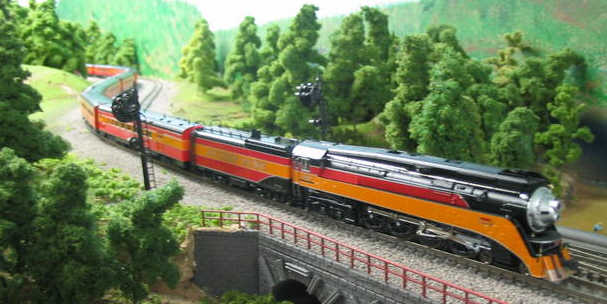
Now the bad news. The first run of this locomotive has a design flaw that makes DCC operations completely impossible (your decoder will melt down, so don't even try). The issue has something to do with the rear drivers and the way they move around - the end-result being some sort of short-circuit that will instantly fry any decoder installed in the tender. Note - this does not impact non-DCC operations at all. If you're not a DCC-guy, no worries.
The good news is that Kato came out with a retroactive fix that they will provide to you free of charge (along with an instructional DVD showing how to install it). Basically it involves installing a couple of thin plastic spacers between the chassis and the rear drivers. The procedure is very simple, requiring only a good pair of tweezers. It takes a couple of minutes tops, and no disassembly is required. Said retro-fix is only necessary on first-run 4-8-4's (the problem having been fixed ahead of time in subsequent runs). The driver bottomplate was also modified slightly after the first production run (an extension off the rear was added to keep the trailing truck from hanging too low when handling the model).
So anyway, minor gripes and DCC design flaws aside, this is still an amazing locomotive. And Kato should be congratulated for their quick response to the DCC issue - fully resolved within weeks of the initial release of the model.
In 2009, this model was released as a Kato "Kobo Custom". Available only on Kato's website, these Kobo models generally consist of standard Kato locos, just with pre-installed decoders. And in the case of the GS-4, a sound decoder. Later that same year, Kato re-released their GS-4 in "Wartime-Era" black paint -

A third production run of GS-4's was released in 2010 (including this Bicentennial "American Freedom Train" version) -

2017 update - a disturbing problem has started to emerge with these models as they age. Namely, cracks in the plastic sleeves that connect the driver pairs together. Vis -

The end result (if the cracking gets bad enough) is that the metal axle nubs will start slipping in their sleeves, the drivers will get out of quarter, and ultimately all hell will break loose. Now, as far as how widespread this problem might be, I really couldn't say. From what I'm told, even the cracked sleeves will work OK for a while (until they get really cracked), so the whole thing may be a ticking time-bomb that hasn't quite exploded yet.
Kato addressed the problem in 2014 by releasing a set of replacement drivers for the GS-4 (part #932035). First off, the plastic sleeves were eliminated on the three non-geared axles (and with the axle ends being changed from round to hexagonal to help keep the drivers quartered). Secondly, the plastic (geared) axle was made larger and sturdier -

While this did solve the "cracking axle" problem, it unfortunately introduced a whole new set of problems. As pictured below, the new bearing blocks (designed for the new metal axles) do not fit snugly in their chassis cut-outs and are thus prone to falling inward and out of their slots (and with the end result being uneven running, derailing, or flat out locking up).

Max Magliaro (noted N scale locomotive guru) came up with a solution to the problem that involves fabricating custom plastic shims that keep the bearing blocks where they belong. However, it's kind of a long way around the block to fix something that Kato should've addressed on their end.

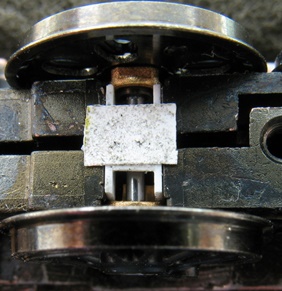
A new production run of these models was released in 2017. And although they make use of the same "revised" drivers introduced in 2014, the problem with the loose bearing blocks appears to have been resolved. I'm not exactly sure what changed, but my guess is that the frame was modified slightly to accommodate the new bearings. But whatever the case, the new drivers work great now and should last forever (or at least as "forever" as anything gets in model railroading).

Prototype information (Daylight GS-4) -
The GS-4 runs on eight massive 80' drivers, 300lbs psi boiler pressure, and puts out a roaring 5,500 horsepower at 55mph, with a maximum speed of 110 mph. The large drivers gave the locomotive a high top speed; the telling mark of a steam engine built for passenger service. The GS-4 was built for the Southern Pacific Railroad by the Lima Locomotive Works and delivered in the early 1940's for the SP's premier passenger trains, finding its way to the Daylight series of name trains. One of the more unique specifications for the GS-4 by the SP was its Mars light, a necessity with the large amount of grade crossings and fog present on the West Coast. The Mars light, like ditch lights on modern locomotives, was utilized as a warning for grade crossings that a high speed train was approaching, its shifting light patterns serving as an eye catcher in foggy conditions.
Prototype information (Wartime GS-4) -
The N scale Southern Pacific GS-4 is back and sporting an all-new look - 1940's wartime-era black paint to reflect a time when GS-4's did more than just passenger service, doing double duty pulling freight as well as moving the Morning Daylight up and down the California coast, having the lettering "Southern Pacific Lines" until as late as 1946 where the lettering changed to a larger "block" style. The black paintjob not only made the locomotive less visible from the air, it also meant easier repainting and maintenance when the locomotives got dirty; an easy thing for a big steam locomotive to do, especially when pulling freight duty pulling grain hoppers or coal.
Prototype information (American Freedom Train GS-4) -
From 1975 to 1976, in celebration of the United States' 200th birthday, GS-4 #4449 was re-painted into a striking red, white, and blue paint scheme, and put into excursion duty pulling a special display train all around the United States.
Prototype information (BNSF Excursion GS-4) -
In 2000, the Daylight was repainted black and silver for a Burlington Northern Santa Fe employee appreciation special. It was to celebrate the BNSF freight railroad and to commemorate the days of the 4449 and other GS locomotives assigned to freight, helper, or local passenger trains. This train excursion went through Seattle, Washington and then east into Montana before heading back to her home in Portland, Oregon.
Model Features:
- Designed to accompany the Kato Southern Pacific "Morning Daylight" Passenger Train sets, able to pull all 18 cars without assistance
- Drivers are operated by functional side rods for smooth performance
- Electrical pickup from both driver and tender for constant electrical connection
- Directional, operating (simulated) Mars light
- Directional headlight
- Illuminated number boards
- Detailed cab interior
- Front and rear kato magnetic knuckle couplers
- All detail parts installed
- DCC friendly design, designed to take the EM13 Motor Function Decoder (Item #29-351, MSRP: $22)
Grade: A (as long as the axles are still good)
Reviewed 07/08 Model Railroader ("A set of newly tooled N scale passenger cars and a GS-4 locomotive from Kato U.S.A. live up to the good looks of their prototypes. Sold separately, the locomotive, 10-car set, and four add-on two-unit articulated chair cars let N scalers model a full 18-car postwar Morning Daylight.
The GS-4 performed well on DC and looked great pulling the matching passenger cars around a scenicked N scale layout.
The lettering and pinstripes on the model are in SP lettering gray. The road name, cab number, and Daylight herald are all edged in black like the prototype. The pinstripes aren't edged in black. All lettering and heralds are crisp, straight, and match prototype photos. The orange and red stripes on the locomotive and tender are in alignment. The Kato N scale GS-4 matches drawings in the April 1972 issue of Model Railroader.
Both the locomotive and tender have plastic body shells with sharply engraved detail. The tender deck has planking with simulated wood grain and molded hatches. The GS-4 also has many separately applied parts, such as handrails, pilot air hoses, and non-functioning classification lamps. A plated airhorn is correctly placed in the skyline casing above the front of the boiler. The windows on the vestibule cab have glazing. Although it's difficult to see without removing the roof, the cab interior features an engraved backhead as well as seats for an engineer and fireman. Figures are not included.
The model comes with factory-installed train indicator boards for No. 98. User-installed boards are included for No. 99 and X4449. The "X" with an engine number indicates an extra train with no timetable schedule.
The locomotive's plastic cab and boiler are press-fit and easy to remove. Inside the boiler, a three-pole skew-would motor with a brass flywheel is connected to a gearbox that drives the third axle. The model's siderods transfer power to the rest of the drivers. The motor is housed inside a split cast-metal frame. This weight along with traction tires on the third drivers give the locomotive enough drawbar pull to haul the equivalent of the full Daylight consist of 18 N scale passenger cars on straight and level track.
A printed-circuit (PC) board on top of the frame controls lighting functions. A separate PC board in the tender controls the motor. The GS-4 is designed for conversion to DCC, and Kato makes a drop-in motor decoder (part no. EM-13) that replaces the PC board in the tender.
In DC the train indicators, number boards, flashing signal light, and headlight came on dimly at 2 volts. The lights reached full brightness at about 2� volts. In reverse, these lights automatically shut off, which isn't prototypical. The tender backup light has a clear plastic lens but is non-operating. At 2 volts, the locomotive rolled steadily at only .6 scale mph. Throughout its speed range, the locomotive's mechanism is very smooth and quiet. At 12 volts, the model reached 130 scale mph, which is higher than the prototype's 110 mph top speed.
I ran the locomotive and cars through an 11"-radius curve of Kato Unitrack without any derailments. The train looks a lot better on 18"-radius or wider curves. The GS-4 pulled the 10 cars up a 2.75 percent grade.
The Kato Morning Daylight passenger cars and GS-4 accurately depict their famous prototypes. Unfortunately the Kato GS-4 wasn't DCC-ready right out of the box, but we hope that issue will be resolved for future runs of the locomotive. Now that Kato provides a fix for the GS-4, DCC operators can also enjoy an accurate model of what many railfans consider the most beautiful train in the world. $198")